USB microphones have continuously been on the rise in the past few years. It’s not hard to imagine why: beginner musicians on a budget are often tempted to buy such a mic, as it saves them from the cost of purchasing an additional sound card. Another reason is that USB microphones are all-around mics that, besides recording music, are useful for gaming, podcasting as well as online meetings.
The versatility of the USB microphones has led to a significant increase in the models that are manufactured: a simple Google search will provide you with dozens of different USB mics, some of which are ridiculously cheap, while others are extremely pricey. This is a result of the technology improvement that led to high-quality USB mics that can be used for high-fidelity musical recordings.
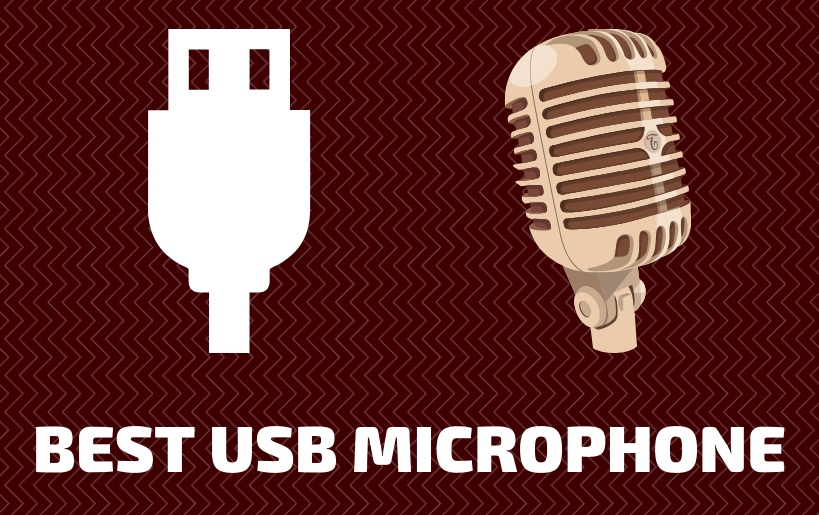
So, if you are looking for a USB microphone to use with your computer, how can you decide which one is for you? To help you with this task, I have gathered a list of the 10 best USB microphones that you can currently find on the market. Each one has its advantages and drawbacks listed, so that you know exactly what every mic’s specifications mean. There is certainly a mic for everyone among these ten, so read on!
Quick Navigation
Best USB Microphones Summary:
Table could not be displayed.Best USB Microphones 2022 Reviewed
1. Rode NT-USB – Best Buy
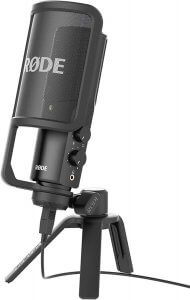
Rode is an Australian brand that is widely known for manufacturing popular microphones at competitive prices. That is the case with the Rode NT-USB, which is part of the brand’s popular NT series. If you are looking for a microphone that can eliminate almost all of the background noises, then this is it. The Rode NT-USB is a quality condenser microphone with a cardioid polar pattern, that records at 16bit and 48kHz. In terms of frequency response, it can handle the whole audible spectrum (20Hz to 20kHz).
Α built-in stereo headphone jack allows you to record with latency-free monitoring, while a long 20-foot USB cable lets you place the mic away from the computer. It is straightforward to use and to set up, and it is compatible with both Windows and macOS software, without any additional driver installation required. The package includes a pop shield and mic stand adapter, along with a desktop tripod.
- Great sound quality and wide frequency range
- Eliminates almost all background noises
- Compatible with most devices and usable out-of-the-box
- Ships with a lot of useful accessories
- A little pricey
2. Blue Yeti – Best Value For Money
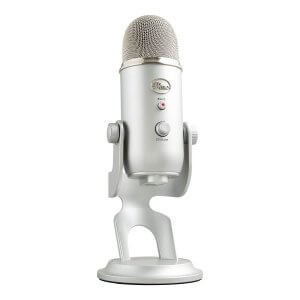
The next microphone comes with a playful name that doesn’t bring a microphone to mind. The Blue Yeti is one of the most popular, all-around USB condenser microphones currently on the market and captures detailed and accurate sound performance. Its distinctive feature is the incorporated TriCapsule, that lets you switch easily between four different polar patterns: cardioid, bidirectional, omnidirectional and stereo. The ability to switch between the patterns gives you extra versatility in different recording situations. This microphone records 16-bit, 48 kHz premium quality sound that you can monitor via the dedicated headphone output, for latency-free listening.
The Blue Yeti is compatible with both Windows and macOS computers. Despite its name, it comes in a variety of colours to choose from (platinum, silver, space grey, black, and white). It has a built-in tripod that allows it to stand on your desk and it ships with a 6-feet long USB cable.
- Crisp and detailed sound quality
- TriCapsule design allows for different polar patterns
- Variety of colours to choose from
- Competitively priced
- Average build quality
3. Audio-Technica AT2020USB – Slightly Pricey
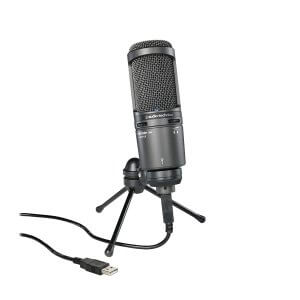
The third entry on this list comes from a well-known audio manufacturer, and it is one of the most popular USB mics currently on the market. The Audio-Technica AT2020USB is a premium-quality USB condenser microphone with a cardioid polar pattern. It is basically the USB version of the already popular XLR condenser mic AT2020, and records at 16bit and 44.1kHz or 48kHz over a 20Hz to 20kHz frequency response. A built-in headphone jack with volume control lets you record without any latency. It is very easy to set up, both on Windows devices (it finds the drivers itself) and on Apple devices (you just plug and play).
The Audio-Technica AT2020USB has sturdy build quality thanks to the metal body that ensures durability. It comes equipped with a little microphone stand, along with a small adapter for a normal stand, as well as an external pop filter and a carrying pouch.
- Crisp sound quality for every purpose
- Robust build quality
- Mic stand, adapter, carrying case and pop filter included
- Easy to set up
- Slightly expensive
4. CAD U37

The CAD U37 is a budget-friendly option for those looking for a USB condenser mic. It records rich and warm sound thanks to its large diaphragm and single cardioid pattern that minimizes background noise. It records 16bit, 48kHz sound, within a wide frequency range from 20Hz to 20kHz. It is compatible with Windows and MacOS, without requiring any additional drivers or software to be installed: you just plug it and it works. Premium additional features of this mic include a 10 db overall protection (using a pad), that allows you to record loud sources without worrying about distortion, as well as a bass-reduction toggle that lets you remove unwanted room noise. The CAD U37 ships with a desktop stand along with a long 10-foot USB cable.
Overall, the sound quality of this mic is not as good as higher-priced models, but it is decent enough if you want to use it for voice and speech.
- Affordable
- 10 db protection pad
- Bass-reduction switch
- No additional software required
- Average sound quality
5. Samson Go Mic
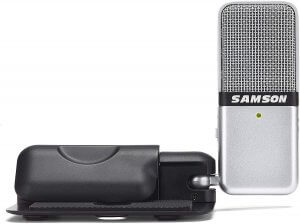
The Samson Go Mic, as its name suggests, is a nice solution for those who like to record on the go. It is an extremely compact (almost as big as your palm) and portable USB condenser mic that can sit at your desk or be clipped to your laptop screen. Despite the size, it delivers surprisingly good sound quality at 16-bit, 44.1kHz resolution. It records smoothly with a flat frequency response along a large spectrum of 20Hz–18kHz. Due to its small size, the Samson Go Mic can’t handle very loud sounds, but it will perform decently at tasks such as voice recording. One of its best features that are not expected at this price is the switchable cardioid or omnidirectional pickup patterns that give you versatility when recording.
A stereo 1/8″ headphone output ensures no latency monitoring while you record.. The Samson Go Mic is compatible with Windows and macOS operating systems, without requiring any software to be installed: you just plug it and hit record. The package includes a USB cable, a cable clip and a carrying case for maximum portability.
- Value for money
- Very compact and portable
- Switchable polar patterns
- Latency-free monitoring
- Can’t handle high pressure levels
6. Sennheiser MK4 Digital
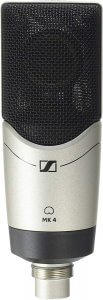
Sennheiser has been around for a long time in the audio niche, creating professional-level equipment. The Sennheiser MK4 Digital is a USB condenser microphone that comes as an upgrade of the already successful Sennheiser MK4, incorporating a high-quality digital-to-analog converter that allows this mic to be connected via USB. It records with astonishing sound quality and a sample rate of 44.1/48/88.2/96kHz, at 16 or 24 bits, with a frequency range that covers the whole audible spectrum (20Hz-20kHz). That happens thanks to its gold-plated 1-inch capsule that records in a cardioid pattern.
This mic is perfect both for vocal recording and acoustic instruments. It comes equipped with a microphone mount, two USB cables (one for the computer and one for iPad or iPhone) as well as a cloth bag for storage. The biggest drawback of the Sennheiser MK4 Digital is the price: it is very expensive for an average user.
- Amazing sound quality
- Great choice of materials
- Useful extra accessories
- Can record directly to an iPad or iPhone
- Too expensive
7. Shure MV5
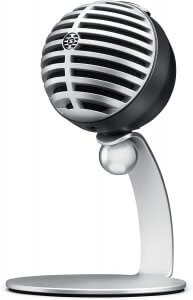
The Shure MV5 is a small-diaphragm, cardioid condenser microphone that comes with USB connectivity for use without a sound card. It records 24bit/ 48 kHz high-quality sound along with a frequency range of 20 Hz to 20 k Hz. A 3.5mm headphone output allows you to record with latency-free monitoring. A nice feature of this mic is the DSP button that lets you cycle through three preset modes (vocals, flat, or instrument), to have the best performance for each occasion.
The Shure MV5 comes with a dedicated MOTIV app for iOS users that lets you apply effects such as EQ and compression to the mic. It features beautiful, retro-looking design and comes in two different colour combinations: either in black colour with a red windscreen or in gray color with a black windscreen. The Shure MV5 has sturdy build quality (typical for Shure products) and ships with a steel metal stand. The compact and lightweight design allows it to be carried around easily.
- Pristine sound quality
- Dedicated app with lots of features
- Good-looking design
- Robust build quality
- ShurePlus Motiv app is only for iOs users
8. Behringer C-1U

The Behringer C-1U is the USB upgrade of the original analog condenser C-1 microphone. It is a very affordable medium-diaphragm USB mic with a cardioid polar pattern and a frequency range from 40Hz to 16kHz, that records decent sound quality for the price. The cardioid polar pattern allows it to eliminate background noise quite effectively. On the downside, you might find that the output volume is quite low, compared to other mics.
It is very easy to set up without requiring any additional software to be installed. The design of the Behringer C-1U is sleek, and it is made from rugged aluminium with a metal grill. As a result, it has an overall solid build quality that will make it last for long. The package includes a stand mount, a mic stand, a 5/8″ to 3/8″ mic stand adapter and a USB cable.
- Cheap
- Plug-n-play
- Sturdy build quality
- Useful extra accessories included
- Low volume output
9. Samson Meteor USB Microphone
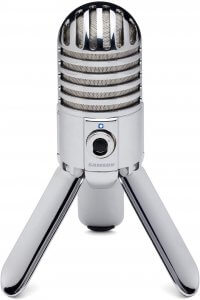
The second entry from Samson on the list, is a step up from the previously mentioned Samson Go Mic, but it still remains quite affordable. The Samson Meteor USB microphone is a condenser microphone with a cardioid pickup pattern that delivers great sound quality. It records at 16-bit, 44.1/48kHz and has a flat frequency response with a 20-20kHz frequency range. The Samson Meteor comes with a built-in ⅛” headphone port for monitoring without latency. A dial lets you adjust your monitoring volume levels and there is also a mute button.
It is compatible and works flawlessly with both Windows and MacOS operating systems, without the need for any additional drivers. It is made with a retro design that features chromed steel, resulting in great build quality. The design is both stylish and clever as it incorporates a tripod stand by opening the folded legs of the mic. It ships with a nice small velvetine bag that along with its compact and lightweight design, make it highly portable.
- Great sound performance
- Stylish and functional design
- Latency-free monitoring
- Mute button
- No 24-bit sampling rate
10. Blue Snowball Ice

Last but not least, the Blue Snowball Ice is another budget-friendly USB condenser microphone from the “Blue” brand that comes as an upgrade to the popular Blue Snowball USB mic. It features a cardioid polar pattern and records crisp and detailed sound performance at 44.1kHz/16 bit. It covers a wide frequency range of 40 Hz to 18 kHz. This mic does not have any built-in DSP (digital signal processing), allowing you to record pure signals that you can edit later on your DAW.
The Blue Snowball Ice is compatible with both Windows and MacOS operating systems that instantly recognise it, without any additional software required. It comes with good-looking, retro design and two different colours to choose from (black and white). Its compact size and lightweight design allow it to be carried everywhere with ease. A tripod desk stand that lets it sit in front of the computer, as well as a USB cable ship along with the microphone.
- Bang for the buck
- Plug-and-play
- Nice design
- Compact and portable
- No headphone jack
Now that the list is over, are you still undecided about which one of these mics you should get? Well, there are a number of factors that you should consider in order to choose the one that fits your needs. First of all, your budget plays an important role: if you have very little money to spend, then the choice might be easier for you. However, pay attention to the extra accessories that come with each mic, as they might save you money.
Another important thing is what you are planning to do with the mic. If you want to record music, then latency-free monitoring is important for you, especially if you like recording multiple tracks. In addition to that, recording multiple acoustic instruments might require a microphone with switchable polar patterns for maximum versatility. On the other hand, if you want to use your mic for online meetings and speech, these features are not important for you.
Last but not least, if you plan to carry around the mic a lot, then try getting one that has robust build quality and can handle a little rough treatment, along with being compact and portable. A carrying case might also prove useful on this occasion. All in all, USB microphones are here to stay, and they have vastly improved all of their specifications in the past few years, so you will definitely be satisfied with whichever mic of the list you pick!
Best USB Microphone – Detailed Buying Guide
There is no doubt that the rise in popularity of USB microphones is justifiable: this relatively cheap and easy solution has helped countless beginner musicians, gamers and youtubers to record high-quality audio without spending extra money on a sound card. However, this rise in popularity has produced a great amount of different models, as more and more brands produce USB microphones, and has made it quite hard for the buyers to choose which model is right for them. To help you in this quest, I have created the following buying guide that explains what you should pay attention to when looking for a USB mic.

Sound quality
Sound quality should always be the most important factor when looking for a microphone. However, this doesn’t mean that you should opt for the largest sample rate and widest frequency spectrum: depending on what you are planning to use the mic for, you should decide on the appropriate specifications (for example, podcast recording might have lesser requirements than musical vocals recording). The majority of USB microphones come with a cardioid polar pattern that fits most occasions, but if you need versatility, you might want to check mics that incorporate switchable polar patterns. This feature lets you record easily with different polar patterns instead of using different microphones each time.
Included accessories
Many USB microphones ship with useful accessories for recording. Usually those include some or all of the following: a mic stand, an adapter, a pop filter, a cable, a cable clip and a carrying case. If you already own part of this equipment, the extra accessories might prove useless and you can save money by buying a better microphone without the extra stuff. On the other hand, if you don’t have a mic stand or a pop filter, getting a USB microphone that includes them in the package can save you quite some money.
Build quality
Build quality is something that few buyers pay attention to, but it should be an important factor if you plan to be rough to your microphone. You shouldn’t get a mic that is too fragile if you want to carry it around, so watch out for the materials that have been used to create it. Robust build quality also makes a product durable, adding to its overall value.
Portability
One of the features that makes USB microphones so popular is their portability: you don’t have to carry a sound card, and they are compatible with most operating systems. Compact and lightweight microphones are easy to transport, and there are even some microphones that have a built-in tripod so that you don’t have to look around for a mic stand. Don’t forget that if you want to carry your mic around, a carrying case is mandatory, so you might want to buy one that ships with a case or pouch.
Ease of use
USB microphones are mostly aimed at beginners, and if you are one of them, you should probably get a mic that is easy both to set up and use. Most USB microphones are “plug-and-play” both for iOs and WIndows, which means that you won’t have to install any additional software to your computer in order to record. Some of them can even record directly on tablets and smartphones, a feature that can be useful if you are not planning to use your computer for recording.
Direct monitoring
Most of the high-end USB microphones offer direct monitoring. This is achieved through a headphone port on the body of the mic that lets you plug your headphones and listen to your voice without any latency. Depending on the model, this function might be accompanied by a knob that lets you adjust the volume and/or a mute button that blocks the signal transmission. This can be useful if you like recording voice-overs, but if you want to record vocals over other instrument tracks, you might need to monitor through the computer and never use this function.
Budget
The budget is always a definitive factor when someone is looking to buy something. There are many USB microphones currently on the market that have great value for money. However, those budget-friendly options are not always the best for everyone. A lot of these microphones that are bang-for-the-buck lack useful accessories or features that might lead a demanding user to buy stands and pop filters or replace the mic for a better one within a couple of years. That is why to understand whether a mic is expensive or not for you, you should take note of all of its features.
Extra features
Some popular USB microphones come in different colours to choose from, while others come with built-in desk stands, as we mentioned earlier. Not everyone is interested in a microphone’s look and design, but if you want a good-looking microphone, you should pay attention to these features. For demanding audiophiles, there are USB microphones with attenuation pads as well as bass-reduction switches. Finally, if you want to control your microphone remotely, there are also a couple that come with a dedicated app that you can control from your smartphone or tablet.
Final Words
As you have probably realized by now, there are many different things that one should be aware of before buying a USB mic. Should your mic meet all the previously mentioned criteria? Of course not! For example, if you don’t plan to carry it around, portability is not important to you, but you might want to buy a mic with direct monitoring for latency-free recording. If you are a beginner, you probably need a mic that is easy to use and to set up while extra accessories may be useless to you. Before deciding on a microphone, note down what you are planning to use it for and which of the previously mentioned specifications are important to you. I hope that this guide has helped you understand what you should pay attention to in order to get the best USB mic for your needs!